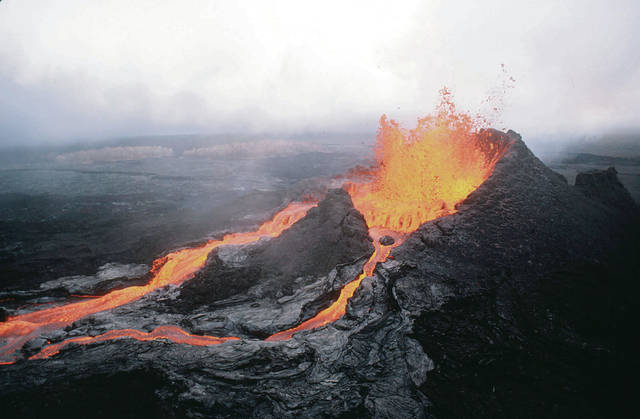Just another day at Kilauea Volcano: Eruptions continue at the summit and at the Puu Oo vent. While the ocean spigot is turned off for the moment, lava is still rolling across the higher terrain.
Currently it poses no threat to Hawaii island communities.
Thirty-five years ago today, Kilauea Volcano sprang to life as several fissures broke out on the East Rift Zone. Over the next three years, a series of 44 fountains built what became known as Puu Oo.
In all since Jan. 3, 1983, Kilauea has covered more than 55 square miles of land, added 443 acres of land to the island’s southeastern coast, destroyed 215 structures and buried nearly nine miles of highway with lava as thick as 115 feet, according to the Hawaiian Volcano Observatory.
“What sets it apart from other eruptions is the longevity,” said
Daniel Akaka Jr., director of cultural affairs at Mauna Lani Bay Hotel &Bungalows, who witnessed the early-1983 fountaining from Hirano Store in Glenwood. “This is a part of nature that is very much alive and fresh. Pele continues to build, continues to take, but she gives back. She renews.”
By June 1983 the eruption had narrowed to a single event that produced spectacular lava fountains.
Scientists admit they thought the eruption would end long ago, but with surprise and delight have reaped the bonanza of research that ensued.
“It has been virtually a unique opportunity to look at the same eruption over an extended period,” said Michael Garcia, a University of Hawaii volcanology professor, by telephone Tuesday. “No Hawaiian eruption, historically, has been this extended.”
This “changed the world of geology,” Garcia said. “One of the most important findings is the way in which lava flows grow. In part they grow by injection. Under the surface you develop a subterranean tube system that inflates the lava flows and allows them to extend for many miles.”
Another revelation was the flows’ pace.
“We initially thought (the flow formation) took hours to days, and now we know it takes days to months,” said Garcia. “It’s a slow process — a long-term eruption instead of a short, catastrophic flood.”
A third major finding was the wide variety in source material.
“The early Puu Oo lavas are totally different from those today in terms of major trace elements and isotopes,” he said. “It shows that the same source is heterogeneous. In the same eruption, different parts of the mantle are melted.”
Janet Babb first came to
the volcano observatory as a volunteer in 1990, when lava wiped out the community of Kalapana and destroyed the famed Black Sand Beach. By the end of the year, the entire town, including a church, store and 100 homes, was buried beneath 50 to 80 feet of lava.
Now a research geologist at the observatory, Babb recalls differences — but also similarities — to the years 2014-15, when lava flows threatened the town of Pahoa.
“It’s a very stressful time for volcanologists when people are being directly impacted by the eruption,” she said by telephone Tuesday. “It’s really more enjoyable when the new flows are simply covering older flows.”
Her decades at the volcano have only boosted her enthusiasm.
“It’s more than just a job,” she said. “All volcanologists are passionate about their work. We study volcanoes for a reason. On an active volcano the only constant is change. And the changes come, if not hourly, daily and weekly.”




